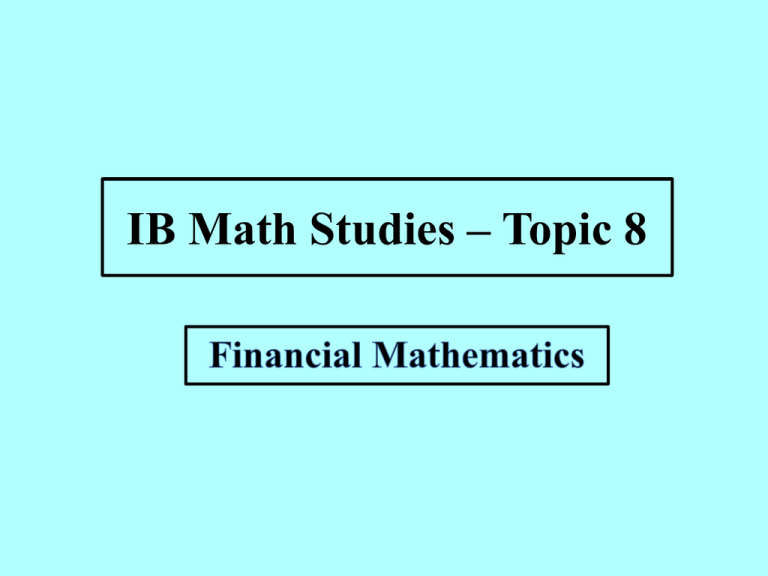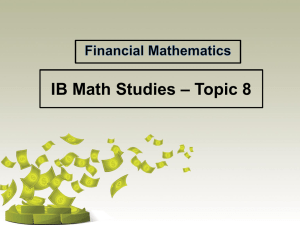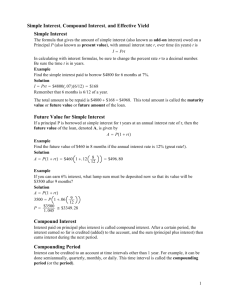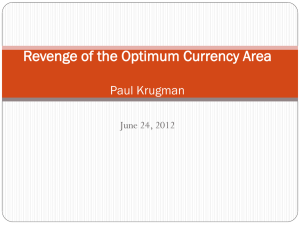Review Topic 8 PowerPoint III
advertisement

IB Math Studies – Topic 8 IB Course Guide Description Introduction Vocabulary: • Currency – money • Exchange Rate – establishes a relationship between the value of currencies. These are constantly changing. • Conversion – exchanging/converting currencies. • Commission – amount/percentage made by exchanging agency Percentage increases and decreases • To increase a percentage – Add the percentage on to 100 • To decrease a percentage – Take away from 100 Both: Divide the resulting amount by 100 and multiply by the amount you wish to increase or decrease Question Working Increase 200 by 10% 200 + (0.10 x 200) = 200(1 + 0.10) = 200(1.10) = 220 Increase 150 by 15% 150 + (0.15 x 150) = 150(1 + 0.15) = 150(1.15) = 172.5 Increase 300 by 17.5% 300 + (0.175 x 300) = 300(1.175) = 352.5 Decrease 200 by 10% 200 – (0.10 x 200) = 200(1 – 0.10) = 200(0.90) = 180 Decrease 750 by 1.5% 750 – ( 0.015 x 750) = 750 (1 – 0.015) = 750(0.985) = 738.75 Reciprocals • You can use proportions to solve currency conversion questions Example: 1 GBP = 1.80 US $ 1 𝐺𝐵𝑃 𝑥 𝐺𝐵𝑃 = 1.80 𝑈𝑆$ 1 𝑈𝑆$ Cross multiply and divide. x = 0.56 GBP Commission • Banks and other currency traders earn a commission for exchanging currency. • Commission rates are usually between 0.5% to 3% • If there is no commission, then the exchange rates will be worse Examples Questions of Commission Examples Questions of Commission 1. Converting 500 UK pounds to US dollars were 1 UK pound buys $1.8734 US 1. Commission: 7.50 pounds 2. Customer receives: $923 US 2. Converting 350 UK pounds to euro where 1 UK pound buys $.5071 euro 1. Commission: 5.25 pounds 2. Customer receives: 175 euros Interest • There are two types of interest: simple and compounded. Simple: Compounded: Simple Interest - Examples • What flat rate of interest does a bank need to charge so that €5000 will earn €900 simple interest in 18 months? • How long will it take $2000 invested at a flat rate of 12.5% p.a. to amount to $3000? Compound Interest Compound Interest - Continued Compounding period yearly 1 times per year k=1 half-yearly 2 times per year k=2 quarterly 4 times per year k=4 monthly 12 times per year k = 12 daily 365 times per year k = 365 Compound Interest - Examples Compound Interest - Examples a) $5359.57 b) $7293.04 c) 9300.65 pounds a. 113.40 euro b. $1170.26 c. $6663.24 Repayment • Repayments are often made in regular payments over the length of the loan. • These may be weekly, fortnightly, monthly or another period of time. Calculating Repayment 1. 2. 3. 4. Calculate the interest Calculate the total amount to be repaid (capital + interest) Calculate the total number of payments Determine the amount of a regular payment total to be repaid regular payment = number of repayments Repayment - Examples Repayment - Examples 1. $274.84 2. 787.50 baht 3. $1418.75 Loan and repayment table Example • Francine takes out a personal loan for $ 16 500 to buy a car. She negotiates a term of 4 years at 11.5% p.a. interest. – Calculate the monthly repayments Check your answers • From the table, the monthly repayments on each $1000 for 4 years (48 months) at 11.5% p.a. = $26.0890 • Repayments on $16 500 = $26.0890 x 16.5 (16.5 lots of $1000) = $430.4685 = $430.50 Inflation • Inflation is the increase in prices of goods and wages • If inflation rate is constant over a number of years, we can use compounded interest Example: In a period where inflation is running at 5, find the price of a television that originally costs $450 after 4 years. 𝐴 =𝐶 1+ 𝑘𝑛 𝑟 100𝑘 = 450 1 + (1)(4) 5 = 100(1) $546.98











